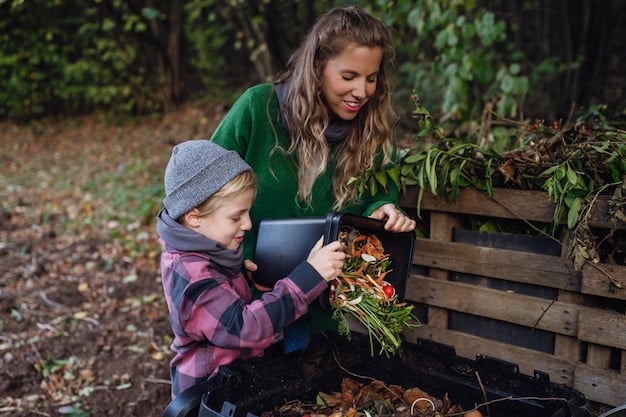How to Talk to Your Family About Sustainable Living: A Practical Guide

Talking to your family about sustainable living involves understanding their perspectives, providing clear and relatable information, and leading by example with your own eco-friendly choices, fostering a collaborative approach to environmental responsibility.
Embarking on a journey towards sustainable living is easier when those closest to you are on board. But how to talk to your family about sustainable living, especially when they hold differing views, can be a challenge. This guide offers practical strategies to foster understanding and encourage eco-friendly choices within your family.
Understanding Your Family’s Perspectives on Sustainability
Before initiating a conversation about sustainable living, it’s crucial to understand your family’s current viewpoints. Recognizing their beliefs and concerns will help you tailor your approach and create a more receptive environment for dialogue.
Identifying Existing Beliefs
Begin by observing your family’s actions and listening to their conversations. Do they already practice some form of sustainability, such as recycling or conserving energy? Or do they express skepticism or resistance towards environmental issues? Understanding their existing beliefs is the foundation of an effective dialogue.
Addressing Common Concerns
Many people have concerns about the practicality, cost, or impact of sustainable living. Some may believe it requires significant lifestyle changes or sacrifices. Addressing these concerns with factual information and relatable examples can help dismantle misconceptions and open the door to a more collaborative discussion.
- Financial Implications: Show how sustainable choices can save money in the long run, such as using energy-efficient appliances or reducing food waste.
- Lifestyle Changes: Emphasize small, manageable changes that can be integrated into daily routines without significant disruption.
- Effectiveness: Provide evidence of the positive impact of sustainable practices on the environment and community.
Understanding your family’s perspectives lays the groundwork for constructive conversations. By acknowledging their viewpoints and addressing their concerns, you can foster a more open and receptive exchange about sustainable living.

Starting the Conversation: Tips for Effective Communication
Initiating a conversation about sustainable living requires a thoughtful approach to ensure productive and positive dialogue. The goal is to foster understanding, not to create conflict or impose your beliefs.
Choosing the Right Time and Place
Select a time when everyone is relaxed and receptive, such as during a family dinner or a weekend gathering. Avoid bringing up the topic during stressful or hurried moments. The setting should be conducive to open and comfortable conversation.
Using “I” Statements
Express your thoughts and feelings using “I” statements to avoid sounding accusatory or judgmental. For example, instead of saying “You’re wasting water,” try “I’m concerned about our water usage and would like to explore ways to conserve it.” This approach promotes a more empathetic and constructive exchange.
Active Listening
Practice active listening by giving your full attention to what others are saying. Show genuine interest by nodding, asking clarifying questions, and summarizing their points of view. This demonstrates respect and encourages them to reciprocate.
- Nod and make eye contact: Show you are engaged and listening attentively.
- Ask open-ended questions: Encourage them to elaborate and share their thoughts in detail.
- Summarize their points: Ensure you understand their perspective and show that you value their input.
Effective communication is key when discussing sustainable living with your family. By choosing the right time and place, using “I” statements, and practicing active listening, you can create a space for open and productive dialogue, fostering mutual understanding and respect.
Sharing Information: Making Sustainability Relatable
When discussing sustainable living, it’s essential to present information in a way that resonates with your family’s values and interests. Making the topic relatable and personally relevant can increase their willingness to consider and adopt eco-friendly practices.
Connecting to Family Values
Highlight how sustainable living aligns with your family’s core values, such as health, financial security, or community well-being. For example, if health is a priority, emphasize the benefits of organic food and clean air. If financial security is a concern, discuss the long-term savings associated with energy-efficient choices.
Sharing Personal Experiences
Share your own experiences with sustainable living, highlighting the positive outcomes and personal satisfaction you’ve gained. Whether it’s growing your own vegetables, reducing your carbon footprint, or supporting local businesses, sharing your journey can inspire others to take similar steps.
Focusing on Tangible Benefits
Instead of overwhelming your family with abstract environmental concepts, focus on the tangible benefits of sustainable living. Discuss how reducing waste can save money, how cycling can improve fitness, or how supporting local farmers can strengthen the community. Concrete examples make the topic more accessible and engaging.
Sharing information effectively involves connecting sustainable living to your family’s values, sharing your own experiences, and highlighting tangible benefits. This approach can make the topic more relatable and increase their receptiveness to adopting eco-friendly practices.
Leading by Example: Demonstrating Sustainable Practices
One of the most effective ways to encourage sustainable living within your family is to lead by example. Demonstrating eco-friendly practices in your own life can inspire others to follow suit and create a positive ripple effect.
Making Visible Changes
Start by making visible changes in your daily routines. Reduce your consumption of single-use plastics, conserve water and energy, and choose sustainable transportation options whenever possible. These actions demonstrate your commitment to sustainable living and serve as a constant reminder to others.
Involving Family Members
Invite your family members to join you in sustainable activities, such as gardening, recycling, or volunteering for environmental causes. Make it a fun and collaborative experience, focusing on the positive aspects and shared goals. Involving them directly can foster a sense of ownership and commitment.
Sharing Your Knowledge
Share your knowledge and insights about sustainable living with your family. Explain the reasons behind your actions and the impact they have on the environment. Be patient and understanding, and encourage them to ask questions and explore the topic further.

- Start a Family Garden: Grow your own produce and teach your family about organic gardening practices.
- Organize a Recycling Station: Set up a designated area for sorting and recycling materials.
- Plan Eco-Friendly Outings: Choose activities that promote sustainability, such as hiking, biking, or visiting local farmers’ markets.
Leading by example is a powerful way to inspire sustainable living within your family. By making visible changes, involving family members, and sharing your knowledge, you can create a culture of environmental responsibility and foster a more sustainable lifestyle for everyone.
Addressing Resistance: Navigating Disagreements and Skepticism
When discussing sustainable living with your family, you may encounter resistance, disagreements, or skepticism. It’s essential to address these challenges with patience, empathy, and a willingness to find common ground.
Validating Their Concerns
Acknowledge and validate your family members’ concerns, even if you don’t agree with them. Show that you understand their perspective and that you value their opinions.
Providing Factual Information
Counter misconceptions and skepticism with factual information from credible sources. Present the data in a clear and accessible manner, avoiding technical jargon or overwhelming statistics. Focus on the positive impacts of sustainable living and the potential benefits for your family and community.
Finding Common Ground
Identify areas where you and your family members agree, and build upon those shared values. Focus on the common goals of health, financial security, and community well-being, and explain how sustainable living can contribute to those objectives.
Navigating disagreements and skepticism requires patience, empathy, and a willingness to find common ground. By validating their concerns, providing factual information, and focusing on shared values, you can foster a more open and collaborative conversation about sustainable living.
Celebrating Successes: Reinforcing Positive Behaviors
As your family members begin to adopt sustainable practices, it’s important to celebrate their successes and reinforce their positive behaviors. Recognizing and appreciating their efforts can encourage them to continue along their eco-friendly journey and inspire others to join in.
Acknowledging Small Victories
Acknowledge and celebrate even the smallest victories, such as reducing waste, conserving water, or choosing sustainable products. Positive reinforcement can motivate your family members to continue making progress and build upon their achievements.
Sharing the Benefits
Share the benefits of sustainable living with your family, highlighting the positive impact on their health, finances, and community. Connect their actions to tangible outcomes, such as reduced energy bills, improved air quality, or a stronger local economy.
Creating a Positive Feedback Loop
Establish a positive feedback loop by continuously recognizing and appreciating your family members’ sustainable efforts. This creates a supportive and encouraging environment, making them more likely to continue practicing eco-friendly behaviors and inspiring others to do the same.
Celebrating successes is a crucial part of encouraging sustainable living within your family. By acknowledging small victories, sharing the benefits, and creating a positive feedback loop, you can reinforce positive behaviors and inspire continued progress towards a more sustainable lifestyle.
| Key Point | Brief Description |
|---|---|
| 🌱 Start Small | Introduce sustainable practices gradually to avoid overwhelming your family. |
| 💡 Lead by Example | Demonstrate eco-friendly habits in your own life to inspire your family. |
| 💰 Highlight Benefits | Show how sustainability can save money, improve health, and benefit the community. |
| 👂 Listen and Validate | Acknowledge and address your family’s concerns with empathy and facts. |
Frequently Asked Questions About Sustainable Living
▼
Sustainable living is a lifestyle that aims to reduce our environmental impact by making conscious choices that minimize resource depletion and pollution, while promoting long-term environmental health.
▼
Begin by understanding their perspectives and values related to the environment. Choose a relaxed setting for discussion, and use “I” statements to express your own feelings and concerns without sounding judgmental.
▼
Simple changes include using energy-efficient light bulbs, reducing water usage by fixing leaks, recycling regularly, and reducing food waste through meal planning and proper storage, alongside composting food scraps.
▼
Acknowledge their concerns, provide factual information from credible sources, and find common ground by highlighting shared values. Focus on the tangible benefits, like saving money or improving health.
▼
Create a family garden, organize a community cleanup, visit a local farmers’ market, or participate in a DIY project using recycled materials. Make it engaging and educational for everyone involved.
Conclusion
Talking to your family about sustainable living is an ongoing process that requires patience, understanding, and a willingness to lead by example. By employing the strategies outlined in this guide, you can foster a more open and collaborative environment, encouraging your family to embrace eco-friendly choices and contribute to a more sustainable future for generations to come.





